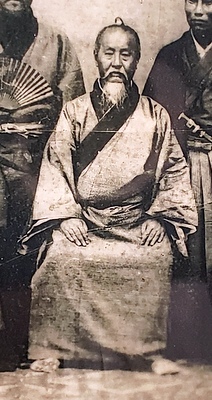Ie Chochoku

- Born: 1818/8/23
- Died: 1896/1/4
- Titles: 伊江 王子 (Ie ouji, O: Ii-wuuji / Prince Ie)
- Other Names: 尚健 (Shou Ken), 朝忠 (Chôchû)
- Japanese: 朝直 (Chouchoku)
Prince Ie Chôchoku was the fifth son of King Shô Kô of the Ryûkyû Kingdom.[1] He played a prominent role in internal court politics of the kingdom in the 1860s, and led a mission to Tokyo in 1872 to formally pay respects to the Meiji Emperor on behalf of his nephew, King Shô Tai.
As a child, he was regarded as mere nobility, and not royalty. However, following the death of his father, King Shô Kô, in 1834, the young Chôchoku (then age 16) was adopted into the house of the anji of Ie, and was raised to the rank of "prince" (O: wuuji). The following year, he was appointed sô-jitô over Iejima, and took on the title of "Prince Ie."
After the Makishi-Onga Incident of 1859, in which a number of high-ranking officials were accused of conspiring with Satsuma han officials behind the back of the royal court, Prince Ie led the investigation as kyûmei sô bugyô (Chief Investigation Magistrate), putting pressure on the pro-Satsuma faction at court.[2]
In July 1872, Prince Ie was named lead envoy on an embassy that would travel to Tokyo to pay respects to the Meiji Emperor. The following month, he was named Sessei (the top administrative position within the Ryukyuan government).[3]
He traveled to Tokyo in 1872 alongside Giwan Chôho and 35 others, meeting with the Meiji Emperor on 9/14, and being formally told that the kingdom was to be annexed by Japan as Ryûkyû han, and that King Shô Tai was to become "king" of that domain. While in Tokyo, he also attended the formal ceremony for the opening of Japan's first railway, connecting Shinbashi and Yokohama. The embassy arrived back in Naha on 1873/3/3 after being briefly castaway on Kikaijima earlier that year, while sailing from Kagoshima to Okinawa.[4] Following his return to Ryûkyû, Ie was named sessei (prime minister, or regent).
Prince Ie was admitted to the kazoku (Meiji Japan's European-style nobility) in 1890 as a Baron (danshaku). He died six years later, at age 79.
References
- "Ie Chôchoku," Nihon jinmei daijiten, Kodansha 2015.
- "Shiryôhen kaidai shiryô honkoku: Edo dachi ni tsuki oose watashi dome" 「史料編解題・史料翻刻「江戸立二付仰渡留」」, in Kamiya Nobuyuki 紙屋敦之 (ed.), Kinsei Nihon ni okeru gaikoku shisetsu to shakai hen'yô 3: taikun gaikô kaitai wo ou 『近世日本における外国使節と社会変容(3)-大君外交解体を追う-』, Tokyo: Waseda University (2009), p45n69.
- ↑ Among his siblings, most were half-siblings, born to different mothers. Prince Ôzato Chôkyô (Shô Jun) (third son of Shô Kô) was his full brother, by the same mother. Yamazato Eikichi, Kochû tenchi 壺中天地, Kakubunsha (1963, repr. 2017), 220.
- ↑ Marco Tinello, "The termination of the Ryukyuan embassies to Edo : an investigation of the bakumatsu period through the lens of a tripartite power relationship and its world," PhD thesis, Università Ca' Foscari Venezia (2014), 395.
- ↑ Kawabata Megumu 川端恵, Shô Tai: Saigo no Ryûkyû ô 尚泰:最後の琉球王, Yamakawa shuppan (2019), 21.
- ↑ Shumi no Kikaijima shi 趣味の喜界島史, Tokyo: Kuroshio bunka kai (1960), 123-124.